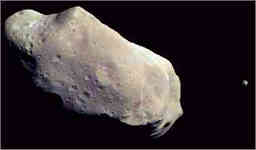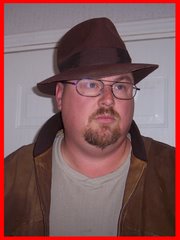 “In late 1991, astronomers detected what may in fact be an extraterrestrial space probe in near-Earth space.” This is definitely something we need to take a closer look at…
“In late 1991, astronomers detected what may in fact be an extraterrestrial space probe in near-Earth space.” This is definitely something we need to take a closer look at…First off we need to look at just who it is who makes such a startling statement? Is he some wild-eyed UFO believer type freako? Or maybe he is just your average renegade scientist wanting to get his 15 minutes of fame? The answer is a resounding No, not at all. His name is Steel, not Remington but rather Duncan Steel.
Who is this Mr. Steel, you wonder? Lets just take a quote from the jacket of his book, Rogue Asteroids and Doomsday Comets (Wiley, 1995): "Duncan Steel, Ph.D. is a research astronomer at the Anglo-Australian Observatory and a research fellow at the University of Adelaide, Australia. A world renowned authority on the comet hazard, he has served on both the Detection Committee and the Intercept Committee created by NASA to assess the threat of comet and asteroid collisions and investigate technologies to avert such impacts." Not only that, but Steel is thought of as a "longtime skeptic" and "as someone who almost invariably has his facts right," according a reviewer in an Australian magazine (Colin Keay in The Skeptic, Vol 15, No.3, 1995).
 So how did Steel come to his startling conclusion? Here's the scoop. On Nov. 6, 1991 Jim Scotti using the Spacewatch telescope at Kitt Peak in Arizona discovered a body which he initially described as a "fast moving asteroidal object," a month before its closest approach to the Earth. The object was classified as 1991 VG. Later, the object's heliocentric orbital elements suggested instead that "the object might be a returning spacecraft." As the approximately 30-foot object, now labeled 1991 VG, neared the Earth, astronomers at the European Southern Observatory tracked it and found strong, rapid brightness variations suggestive of reflections from a rotating spacecraft.
So how did Steel come to his startling conclusion? Here's the scoop. On Nov. 6, 1991 Jim Scotti using the Spacewatch telescope at Kitt Peak in Arizona discovered a body which he initially described as a "fast moving asteroidal object," a month before its closest approach to the Earth. The object was classified as 1991 VG. Later, the object's heliocentric orbital elements suggested instead that "the object might be a returning spacecraft." As the approximately 30-foot object, now labeled 1991 VG, neared the Earth, astronomers at the European Southern Observatory tracked it and found strong, rapid brightness variations suggestive of reflections from a rotating spacecraft.His curiosity piqued, Steel decided to investigate the different probabilities for the nature of this object, according to his account "SETA and 1991 VG," published in The Observatory (Vol. 115, pp. 78-83, 1995). "SETA," by the way, stands for "Search for Extra-Terrestrial Artifacts" within our Solar System. Steel first wondered whether the object could be a returning spacecraft, given those brightness variations and its very Earth-like orbit. But he found that none of the handful of man-made rocket bodies left in heliocentric orbits during the space age have purely gravitational orbits returning them to the Earth at that time. Besides, if 1991 VG was a man-made rocket body, then its return to our vicinity and its accidental detection by Spacewatch was, Steel calculated, a very unlikely event, on the order of one in 100,000 per year.
So could it be a natural body, Steel then asked himself? One factor that strongly argued against this interpretation was the light variation the object exhibited, which resembled those of rotating artificial satellite trails seen in wide field astronomical photographs. The second factor is that the object's pre-encounter orbit of 1991 would have made it unstable in close approaches to the Earth on a time scale measured in millennia. This means, that if it is an asteroid, it would have recently arrived in that orbit, which is, Steel states, very unlikely.
Therefore, concludes Steel, we have to seriously consider the possibility that this object has "an alien genesis." Given our meager surveillance of near-Earth objects, there is little chance that objects of this kind would have been spotted in the past. There is nothing here, in other words, that would contradict the alien probe hypothesis, says Steel.
Steel's probability analysis does not end here. He goes on to tackle an issue that not doubt made his colleagues pale. Was 1991 VG under control or making a random passage by the Earth, he asks? Since only "about one in 50 objects passing randomly within 0.022 AU have perigee heights as low as 0.0031 AU," Steel thinks there is a "possibility that it was a singular alien space probe on a controlled reconnaissance mission."
Steel ends his surprising analysis on a cautious note, however. His personal bias, he states, is that 1991 VG is really a man-made artificial object. But if it was, he concludes, then it's observation was really an incredible fluke. So much so, in fact, that scientists, he says, should "consider the possibility of some other origin for it."
All in all, it's quite an amazing piece of work. Steel is not the kind of scientist who pulls his punches. In his new book about the threat that asteroids and comets pose to life on Earth, he speculates that Stonehenge was originally erected during a period of intense celestial bombardment--some perhaps of Tunguska-like force--about 5,000 years ago. Stonehenge's purpose, he ventures, was "to monitor meteor rates in order to predict when storms were due." Steel doesn't expect this hypothesis to be warmly welcomed by anthropologists and antiquarians. Nor will SETI and SETA astronomers take kindly to the notion that an alien probe may have performed a reconnaissance mission of Earth in 1991. Of course, human-built space probes have done just that in our solar system for the past quarter century. Why couldn't someone out there be taking a peek at us? WEIRD!
I’m Average Joe


No comments:
Post a Comment